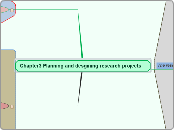Chapter3 Planning and desgining research projects
The research process
1.Selecting the topic
Personal interest
adventage
the knowledge
the possibility
the high level of motivation
disadeantage
biased
unable to view the situation
The literature
Example
Policy or management
organisations
academics
Social concern
deprived or neglected groups
the environment
the health needs of outworkers
Popular issues
Motivation
2.Review the literature
Roles
Risk
Ongoing
Summary and conclusion
3.Devising a conceptual framework
Concepts
The building blocks
Concept, definition, operationalisation
Conceptual framework
Identification of concepts
starting point
iterative
going backwards and forwards between the elements
Definition of concepts
Exploration of relationships between concepts
use concept map
Operationalisation of the concepts
measured , if quantitative in nature
assessed, if qualitative in nature
Whether the research is
Descriptive
Explanatory
Evaluative
Theoretical framework: T=a+bE
4.Deciding research questions
From concept map to research questions
relationship between concepts//variables
influences
Job satisfaction affect organisational commitment
organisational commitment influence staff turnover
research questions
the scale and scope of the implied research program
answerability of the question
scale and scope
Answerability
Theoretical
Big issue
Research questions/manageable subprojects
Practical terms
the resources available to the researcher
Primary and subsidiary questions
Primary
Subsidiary questions
Personal characteristics
Job characteristics
Research questions vs objectives
The objectives of the research
the relative influences
job satisfaction affects organisational commitment
organisational commitment influences the level of staff turnover
Research question vs hypotheses
Research question
Hypothesis to be tested
Hypotheses
Non-directional hypotheses
Directional hypotheses
Confident about the direction of a relationship
Differences in a particular direction
Experimental research
a null hypothesis
No difference between two group
No relationship between two variables
Statistical analysis
null hypothesis probably true
null hypothesis probably false
5. Listing information needs and operationalising
6. Developing a research strategy
Information-gathering methods
Utilisation of existing information
Experimental and observation methods
Qualitative methods
Questionnaire-based surveys
Data analysis methods
Budget and timetable
7. Conducting the research
8. Reporting findings
Research proposals
Self-generated proposal
Academics seeking funding
describe the research
provide a rationale choice
Students seeking approval
Responsive proposal
Consultants
Submission of a written proposal or tender
Submit a detail tender
basis of price
quality of proposal
track record
Briefs
Client organisations
Agenda
Students
Planners and managers
Research ethics
Harm
Confidentiality or privacy
Free choice
Moral pressure on the university students
Captive group
Governments' census
Some research used in anti-social behaviour
Informed consent
Researchers' responsibility
Examples in the physical and mental risks
Grey areas
Guideline of a good survey
General research ethics
Competence
Literature review
Plagiarism
Appropriate acknowledgement
Falsification of results
